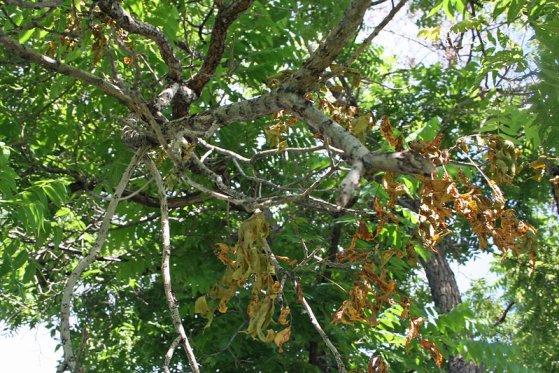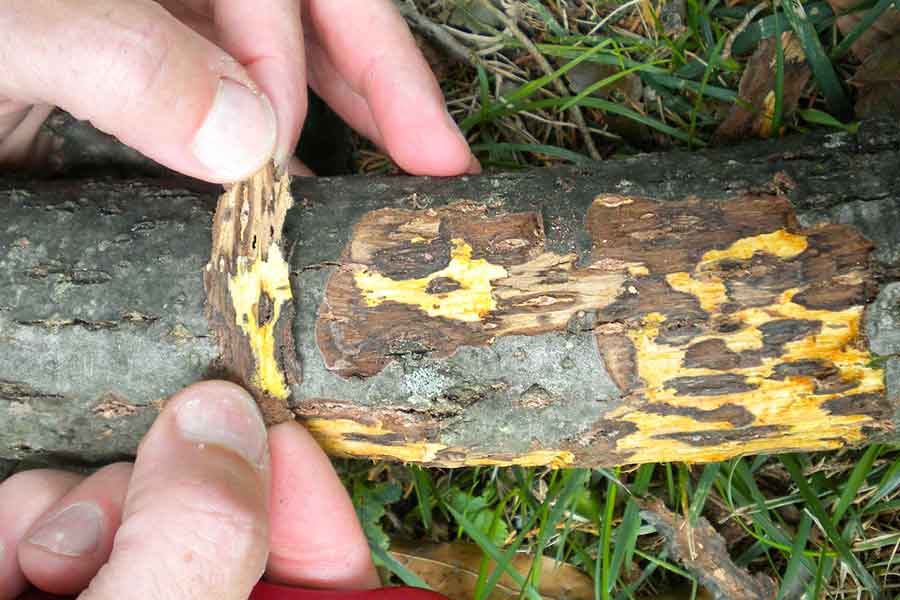Thousand Cankers Disease
(Geosmithia morbida)
French common name: Maladie des mille chancres

Thousand cankers disease is the result of an insect-fungus complex.

Photo by Elizabeth Bush, Virginia Polytechnic Institute and State University, Bugwood.org

Thousand cankers disease can affect many walnut trees, but black walnut is the most susceptible to the disease.
Thousand cankers disease (TCD), a recently recognized disease (2008), is the outcome of an insect-fungus complex resulting from the walnut twig beetle (Pityophthorus juglandis) carrying spores of an invasive fungus (Geosmithia morbida; unknown origin) into eastern black walnut trees as it feeds on its bark (OFAH/OMNR Invading Species Awareness Program, 2012). The walnut twig beetle, native to Arizona, California, and New Mexico, is associated with Arizona walnut (Juglans major) and does not cause any major damage to these trees. However, the walnut twig beetle has expanded its range throughout western U.S. and recently into eastern U.S., attacking the trunks and branches of black walnut trees. The fungus Geosmithia morbida is also carried by the twig beetle, infecting black walnut trees and causing TCD and the eventual death of the tree (USDA, 2013). Thousand cankers disease is not yet present in Canada, but it occurs in U.S. states with close proximity to Canada.
Thousand cankers disease is the result of an insect-fungus complex caused by a beetle, Pityophthorus juglandis, and a canker fungus, Geosmithia morbida. P. juglandis is a dark reddish-brown beetle about 1.5-2.0 mm long as an adult. It is characterized by 4-6 concentric ridges on the upper surface of the shield-like cover behind and over the head (known as the pronotum).
The adult beetle also has yellowish hairs on its head and a sharp angle to its posterior (NIFA, n.d.). The larvae of this beetle are white and C-shaped. The galleries under the bark created by the adult beetles run horizontally (across the grain of the wood), while the galleries created by the larvae tend to be vertical (along the grain of the wood) (USDA, 2013). The adult beetles carry fungal spores of the pathogen, G. morbida, which are then introduced into the phloem of eastern black walnut trees. Once the tree has been infested by this insect-fungus complex, numerous cankers develop around the galleries and complete girdling of the tree is possible (USDA, 2013).
Adult beetles fly to black walnut trees, where they tunnel galleries beneath the bark of twigs larger than 2 cm in diameter and in the trunk. The adult beetles overwinter within these cavities. In late April, the adults resume activity when they fly to branches to mate, excavate new tunnels beneath the bark for egg galleries, and lay eggs.
After emerging from the eggs, the larvae feed for 4-6 weeks underneath the bark and create tunnels that run perpendicular to the egg galleries. The larvae then pupate at the end of these tunnels. Adults emerge to produce a second generation of walnut twig beetles, after which they enter peak flight activity from mid-July to late August. After flying to new sites, the adult beetles enter hibernation in early fall. It is during the creation of egg galleries that the fungus, G. morbida, is introduced into the tree and subsequently grows to create cankers beneath the bark (Colorado State University, n.d.).
The walnut twig beetle, native to Arizona, California, and New Mexico, is associated with Arizona walnut (Juglans major) and does not cause any major damage to these trees. However, the walnut twig beetle has expanded its range throughout western U.S. and recently into eastern U.S., attacking the trunks and branches of black walnut trees. The fungus G. morbida is also carried by the twig beetle, infesting the black walnut trees and causing TCD and the eventual death of the tree (USDA, 2013).
Thousand cankers disease can affect many walnut trees (Juglans spp.), but black walnut (Juglans nigra) is the most susceptible to the disease (NIFA, n.d.).

Jennifer Juzwik, Research Plant Pathologist, USDA Forest Service
Black walnut trees can be infected with TCD for many years before showing symptoms.
Symptoms of TCD include:
- Wilting and yellowing of leaves mid-summer
- Twig and branch dieback leading to a thinning of the canopy
- Numerous distinctive circular oblong cankers growing on the phloem underneath the bark
- Development of thousands of cankers that kill the phloem and cambium, girdling the tree and eventually killing it (NIFA, n.d.; USDA, 2013)
- The bark surface itself may have no symptoms, or can develop a dark-amber to black stain, as well as cracked bark directly above the canker
- Tiny entrance and exit holes created by the walnut twig beetles may also be visible on the dead or dying branches and trunk
- Bark beetle galleries are also typically found within the cankers (USDA, 2013)
If a black walnut tree is showing symptoms of thousand cankers disease, it is important to fully evaluate the tree, as some of these symptoms are similar to other common diseases of walnut or could be signs of decline from other factors, such as environmental stress (NIFA, n.d.).
The spread of thousand cankers disease can greatly hinder the survival of eastern black walnut trees, causing economic, environmental, and social impacts. As black walnut plays an important ecological role in forest ecosystems and is highly valued for lumber and veneer, the spread of TCD can have major consequences (NIFA, n.d.).
Economic impacts
Since beetle tunneling and canker growth only occur in the phloem just beneath the bark, TCD does not diminish the quality of black walnut wood (Kansas Forest Service, 2014). However, it can kill trees within 3 years of symptoms emerging, so supply of black walnut to the forest industry could be reduced if the trees are not harvested in time. Since the black walnut tree is a highly-valued timber species in North America, being used for high-end cabinetry, furniture, musical instruments, and other veneer products, the reduced supply of black walnut trees could have a negative impact on the hardwood forest industry (OFAH/OMNR Invading Species Awareness Program, 2012).
Ecological impacts
Black walnut trees are valuable nut-producing trees, providing a source of nutrition for humans and many forest-dwelling animals. TCD does not affect the nuts of infected trees, so they are still safe to eat (Conservation Commission of Missouri, 2015). However, the loss of black walnut trees from the landscape would mean a lost food source for a wide range of wildlife. Further, the roots of black walnut trees stabilize soil, the foliage provides food for insects and birds, and the trees slow water runoff. Black walnut trees also act as a carbon sink and reduce atmospheric carbon dioxide levels (Conservation Commission of Missouri, 2015). The loss of black walnut trees would therefore mean a loss of these important ecological services. Since the extent of TCD is not fully known, and it is still moving throughout North America, the long-term ecological impacts of TCD are not yet fully understood.
Social impacts
Healthy black walnut trees can grow to become beautiful, large hardwood trees that add to the biodiversity of the rural and urban forest as well as its aesthetic value. Black walnut trees are also commonly used as landscape trees and provide shade within urban areas, offering social and economic value to urban citizens. The loss of black walnut trees could mean a decrease in the aesthetic and social value of hardwood and urban forests.
In order to detect the disease, visually inspecting walnut trees for dieback is currently the best survey tool. To detect the beetle, a pheromone-baited trap is available and should be placed near (but never on) walnut trees (USDA, 2013).
Beyond detection of the disease, there is currently no effective management strategy available to prevent or control thousand cankers disease or the walnut twig beetle. Because the beetles are so small, it is not feasible to spray insecticides to control them. Furthermore, there is no approved fungicide available for injection into black walnuts since this could affect the nut produced by the tree and thus be harmful to humans or animals. Some states have imposed strict sanitation methods by removing all diseased trees, which has proven successful for early and small infestations of TCD (UF/IFAS, 2015).
Quarantines on the movement of non-treated or unfinished walnut lumber and wood products from infested areas should also be imposed to avoid the spread of TCD into new areas.
As the beetle and fungus do not diminish the wood quality of black walnuts, infected trees can still be salvaged for their commercial value. If this is done, the bark, phloem, and cambium should be removed and disposed of properly to avoid movement of the disease to other areas (TCD, 2014).
Colorado State University. n.d. Pest Alert: Walnut Twig Beetle and Thousand Cankers Disease of Black Walnut. Retrieved from: https://extension.colostate.edu/docs/pubs/insect/0812_alert.pdf
Conservation Commission of Missouri. 2015. TCD Kills Black Walnut Trees. Missouri Department of Conservation. Retrieved from: http://mdc.mo.gov/your-property/your-trees-and-woods/tree-diseases-and-pests/thousand-cankers-disease/tcd-kills-black-
Kansas Department of Agriculture. 2012-2016. Thousand Cankers Disease of Walnut. Retrieved from: https://agriculture.ks.gov/divisions-programs/plant-protect-weed-control/thousand-cankers-disease
Kansas Forest Service. 2014. Thousand Cankers Disease of Walnut. Kansas State University. Retrieved from: https://www.kansasforests.org/forest_health/emerging_threats/thousandcankerdisease.html
OFAH/OMNR Invading Species Awareness Program. 2012. Thousand Cankers Disease. Retrieved from: http://www.invadingspecies.com/thousand-cankers-disease/.
Natural Resources Canada. 2013. Thousand Canker Disease. Forest Invasive Alien Species. Retrieved from: http://www.exoticpests.gc.ca/us-details/disease/1000145
TCD. 2014. Treatments. Thousand Cankers Disease. Retrieved from: http://www.thousandcankers.com/treatments.php
UF/IFAS. 2015. Thousand Cankers Disease: A Threat to Black Walnut in Florida. University of Florida, Institute of Food and Agricultural Services (IFAS). Retrieved from: https://ufdc.ufl.edu/IR00008181/00001
Fact Sheets

Add Your Heading Text Here





Add Your Heading Text Here





Add Your Heading Text Here
Best Management Practices





Lorem ipsum dolor sit amet, consectetur adipiscing elit. Ut elit tellus, luctus nec ullamcorper mattis, pulvinar dapibus leo.
Articles
Lorem ipsum dolor sit amet, consectetur adipiscing elit. Ut elit tellus, luctus nec ullamcorper mattis, pulvinar dapibus leo.
Current Research and Knowledge Gaps
Lorem ipsum dolor sit amet, consectetur adipiscing elit. Ut elit tellus, luctus nec ullamcorper mattis, pulvinar dapibus leo.
Further Reading
The Invasive Species Centre aims to connect stakeholders. The following information below link to resources that have been created by external organizations.

